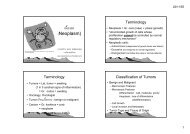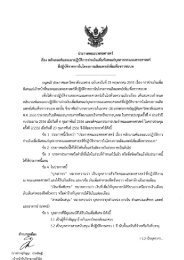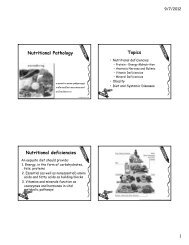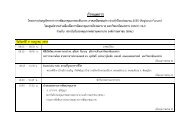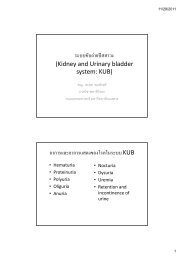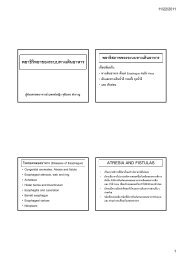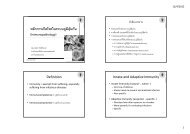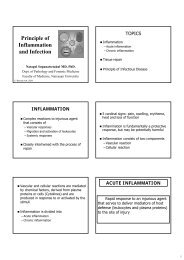VIRAL INFECTION53_1slide.pdf
VIRAL INFECTION53_1slide.pdf
VIRAL INFECTION53_1slide.pdf
- No tags were found...
You also want an ePaper? Increase the reach of your titles
YUMPU automatically turns print PDFs into web optimized ePapers that Google loves.
Content• Viral disease of- Respiratory system- Digestive system- Systemic with skin eruption- Systemic with hematopoietic disorder- Arbovirus and hemorrhagic fever- Warty growths- Central nervous system
Viral structure
Mechanism of viral infection• Attachment• Penetration• Virus uncoating• Replication and protein production• Morphogenesis and maturation• Release of virus
Tissue change caused by viral infection• Cell necrosis• Cell swelling• Inclusion body formation• Giant cell formation• Latent viral infection• Oncogenesis
Classification of viral disease• Respiratory system-Adenovirus, Rhinovirus, Influenza,Respiratory syncytial virus• Digestive system-Mumps virus, viral enteritis,hepatitis virus (A,B,C,D,E)
Classification of viral disease• Systemic with skin eruption-Measles virus, Rubella virus, Varicella zostervirus, Herpes simplex virus 1and 2• Systemic with hematopoietic disorder- Cytomegalovirus, EBV• Arbovirus and hemorrhagic fever-Dengue virus 1-41
Classification of viral disease• Warty growths-Humanpapilloma virus, molluscumvirus• Central nervous system-Poliovirus, Rabies virus, Arbo viralencephalitis virus
Respiratory system
Rhinovirus• Major cause of common cold• More than 100 serotypes• Binding to ICAM-1 1 receptor onepithelial cells of upper respiratorytract• Bradykinin from host responsemucous secretion
Rhinovirus• Clinical feature:Adult:-rhinorrhearhinorrhea, , nasal congestion,sore throat, cough, fever (20%)Child:-fever(60%)• Common complication:Adult:-sinusitisChild:-otitismedia, lower respiratorysymptom (bronchopneumonia)
Influenza virus• Classify due to soluble (S) antigen ofvirion:- subtype A,B,C• Classify due to glycoprotein envelope:- hemagglutinin ( H=1-3 3 )- neuraminidase ( N= 1-212 )- eg.H1N1, H3N2
Influenza virus• Clinical feature:- rapid onset of fever, myalgia,headache, weakness, cough- progressive symptom 3-535 day- clinical subside 2 weeks
Influenza virus• Histology- desquamation of ciliatedcolumnar epithelium of nasophalynx,nasal cavity, bronchi- complication: pneumonia, lunghemorrhage, hyaline membranedisease• Killed viral vaccine: protect 75%
Influenza virus• Avian influenza (Bird flu)- caused by influenza virus type A, H5N1- disease of bird, chicken, duck- transmitted to human by direct contactwith affected animals- virus dies from heat (70 c)
Influenza virus• Avian influenza (Bird flu)- disease in animalslow pathogenichighly pathogenic- disease in humans (2-3 3 days)fever, cough, sore throat,lymphopenia, , severe pneumonia,res. failure, dead
Respiratory syncytial virus(RSV)• Most common cause of self- limitedrespiratory tract infection in youngchildren eg, bronchiolitis, , pneumonia• Transmitted by respiratory droplet andsecretion
histopathology• Upper respiratory tract- mucosal hyperemia, swelling withpredominant infiltration of lymphocytes,monocytes and plasma cells- mucous overproduction causingobstruction of nasal cavity, sinuses andeustachian tube
histopathology• Lower respiratory tract- laryngotracheobronchitis: : swelling ofvocal cord and abundant mucous secretioncausing obstruction of small air way andatelectasis- pneumonia: interstitial infiltration ofmainly lymphocytes
Adenovirus• Classify 42 serotypes• Common cause in child : -- febrile common cold- pharyngoconjunctivitis- exudative tonsillitis- bronchiolitis- pneumonia
Adenovirus• Immunocompromised host:- high riskfor severe pneumonia and frequentlydead
Digestive system
Mumps virus• Paramyxovirus family• Cause of mumps with self limited diseasein 2 weeks• Clinical:- fever, malaise, headache,parotid swelling and pain• Live attenuated mump vaccine
Mumps
pathogenesisInhalation of respiratory droplet contains virusdendritic cells at respiratory epithelium capture virus anddrainage to lymph nodesreplication in lymph nodeshematogeneous spread to parotid glands (parotitis(parotitis),and other organs (CNS, pancreas, testis)
• Extrasalivary gland complication:- aseptic meningitis (most common)- orchitis- oophoritis- pancreatitis
histology• Parotitis: : bilateral 75%- desquamation of ductal epithelial cells- interstitium edema with lymphocytes,• Orchitis:and plasma cells infiltration- testis edema, lymphocytes infiltration,hemorrhage- may be infarction infertility (13%)
Parotitis
Viral enteritis and diarrhea• Rotavirus• Norwalk virus• Corona virus
Rotavirus• Reovirus family• Most common cause of gastroenteritis inchildren < 1 year of age• Clinical :-:fever, vomiting, waterynonbloody diarrhea• Pathogenesis: reduce absorption ofwater and sodium from GI
Rotavirus• Transmission by fecal-oral route• Persistent symptom about 1 week• Treatment: conservative with fluidreplacement
Corona virus• Caused by respiratory tract infection anddiarrhea• Self limited disease• Intermittent epidermiology
Hepatitis virus• Classified 6 types- Hepatitis virus types A, B, C, D,E, G
Hepatitis A virus (HAV)• Transmitted by fecal-oral route(food,water)• Common cause of acute hepatitis• Clinical:- fever, jaundice, nausea, vomiting• Complete recovery• No develop chronic hepatitis andhepatocellular carcinoma
Hepatitis B virus (HBV)• Transmitted by blood transfusion,intravenous drug use, sexual activity,vertical transmission and contactbody secretion eg. . semen, saliva,breast milk• Clinical:- fever, jaundice, nausea,vomiting
Hepatitis B virus (HBV)• Cause of:- acute hepatitis with resolution- chronic hepatitis, cirrhosis andhepatocellular carcinoma- fulminant hepatitis with massive livernecrosis- result for hepatitis D virus infection- carrier
Ground glass hepatocytes of HBV infection
Hepatitis C virus (HCV)• Transmitted by blood transfusion,intravenous drug use, sexual activity,and contact body secretion eg.semen, saliva• Asymptomatic of acute illness
Hepatitis C virus (HCV)• Cause of:- Persistent infection and chronichepatitis- cirrhosis and hepatocellularcarcinoma
Hepatitis D virus (HDV)• Transmitted by blood transfusion,intravenous drug use, sexual activity, andcontact body secretion• Infected with HBV:- coinfection: : expose to serumcontaining both HBV and HDV- superinfection: : chronic carrier of HBVwith new infection of HDV
Hepatitis D virus (HDV)• Clinical:- acute hepatitis- fulminant hepatitis- chronic hepatitis with cirrhosis
Hepatitis E virus (HEV)• Transmitted by water-borne infection• High mortality rate in pregnantwomen(20%)• Self limited in most case• Complete recovery• No develop chronic hepatitis andhepatocellular carcinoma
HepatitisA VirusHepatitis BVirusHepatitis CVirusHepatitis D VirusHepatitis EVirusHepatitisG Virus*AgentIcosahedral capsid,ssRNAEnvelopeddsDNAEnvelopedssRNAEnveloped ssRNAUnenveloped ssRNAssRNAvirusTransmissionFecal-oralParenteral;closecontactParenteral;closecontactParenteral; ; closecontactWaterborneParenteralIncubationperiod2-66 wk4-26 wk2-2626 wk4-77 wk2-88 wkUnknownCarrier stateNone0.1-1.0% 1.0% ofblooddonors inU.S. andWesternworld0.2-1.0% ofblooddonors inU.S. andWesternworld1-10% 10% in drugaddicts andhemophiliacsUnknown1-2% ofblooddonors inU.S.ChronichepatitisNone5-10% ofacuteinfections>50%
Systemic with skin eruption
Measles virus• Cause of measles• Infected by respiratory droplet• Common in children• Self limited disease
Measles virus• Virus multiplies in upper respiratoryepithelium, lymphoid tissue, and spreadto blood• Immunity protect reinfection
Measles virus• Clinical:- conjunctivitis, cough, coryza, , fever- at day 2-3: 2“Koplikspot” at buccalmucosa- at day 4-5: 4reddish-brown rash,enlarged cervical LN- 1 week: subside
Measles virus• Complication:- pneumonia- encephalitis- keratitis- abnormal hemorrhage- secondary bacterial infection
Koplik spot
Measles
pathology• Multinucleated giant cells withintranuclear and intracytoplasmicinclusion (Warthin-Finkeldeycells) inlymphoid organs and other organs
Warthin-Finkeldeycells
Rubella virus• Cause of Rubella• Systemic infection : rash, fever, swollenLN, joint pain, headache, conjunctivitis,• Congenital rubella syndrome in the fetusof an infected pregnant woman ( first 20 thweeks)
Congenital rubella syndrome• Fetal death, premature delivery,congenital anomalies• Heart defects: VSD, PDA, pulmonaryvalvular stenosis• Eye and ear defects: cataract, glaucoma,deafness• CNS defects: microcephaly, , mental retard
Herpes simplex virus• HSV-1 1 and HSV-2• HSV-1:1:- fever blister or cold sores atfacial skin eg. . lip, noseorophalynx- gingivostomatitis at gum,• HSV-2:2:- genital herpes at genitalia(HSV-1 1 may be causes genital herpes)
Herpes simplex virus• Transmitted by direct contact, sexualcontact• Blisters and secretion contains viralparticles
Herpes simplex virus• Gross:- group of intraepithelial vesicles(blisters) and frequently crust covering- may be ulcer• Pathology:- pink to purple, glassy intranuclearinclusion (Cowdry(type A)- mononucleated or multinucleated cells
HSV
HSVglassy intranuclear inclusion (mononucleated(or multinucleated cells)
pathogenesisInitial infection in skin or mucous membranetravel along sensory nerve ending and retrograde axonalflow to neuron in dorsal root ganglia (latent infection)reactivate of latent infected neuron (eg(eg. . stress, fever, UV)newly replicated virus is transported anterograde to a site ator near portal of entry into body causing localized vesicles
pathogenesis
Neonatal herpes infection• Infected fetus by contact vaginal secretioncontains viruses• Clinical features- mucocutaneous vesicles- virus spread to other organs eg. . brain,liver, lung• High mortality rate
Varicella zoster virus (VZV)• Cause of chickenpox, herpes zoster(shingles)• Transmitted by inhalation of airbornerespiratory droplets from an infected hostor direct contact
Varicella zoster virus (VZV)• Primary acute infection of VZV:“chickenpox”• Reactivation of latent VZV: “shingles orherpes zoster” distributes to sensorynerves
pathogenesisprimary infection ( chickenpox)VZV spread from mucosal and epidermal lesionsto local sensory nervesVZV remains latent in dorsal ganglion cells ofsensory nervesreactivation of VZV results in syndrome of herpeszoster (shingles)
Varicella zoster virus (VZV)• Gross:- chickenpox: diffuse, scattered vesicles- shingles: vesicles distribution along the• Histology:peripheral nerve (dermatome)- Intranuclear inclusion of infected cells(multinucleated cells)
chickenpox
shingles
VZVIntranuclear inclusion
Systemic with hematopoieticdisorder
Cytomegalovirus (CMV)• Produce a variety of disease dependon age, immune status• Cause of asymptomatic in healthyperson or severe systemic infection inneonates and immunocompromisedhost ( opportunistic infection)
Cytomegalovirus (CMV)• Transmitted by:- intrauterine transmission- perinatal transmission- breast milk- respiratory droplets- semen and vaginal fluid- blood transfusion- organs transplantation
Cytomegalovirus (CMV)• Clinical feature depends on infectedorgans• Congenital CMV infection– 90% asymptomatic– 10% symptomatic eg. . Hemolytic anemia,jaundice, thrombocytopenia, pneumonia,hepatosplenomegaly, , retinitis, brain damage,mental retard or dead
histology• Large purple intranuclear inclusionsurrounded by clear halo and smallerbasophilic intracytoplasmic inclusion• Organ involvement: salivary glands,kidney, liver, pancreas, brain, ect.
CMV
Epstein-Barr Virus (EBV)• Cause of infectious mononucleosis, self-limited disease• EBV associated with hairy leukoplakia,lymphoma, and nasopharyngealcarcinoma• Transmitted by contact saliva
Epstein-Barr Virus (EBV)• Clinical of infectious mononucleosis:- fever- generalized lymphadenopathy- hepatosplenomegaly- sore throat (patch on tonsil)- may be CNS lesion- may be hepatitis, pneumonia
pathogenesisEBV replicates in B-lymphocytes Bin tonsilB-lymphocytes disseminates in circulationAtypical T lymphocytes in blood circulation
Atypical T lymphocytes
Arbovirus and hemorrhagicfever
Dengue virus• Dengue virus 1-41• Dengue fever is a vector-bornedisease• transmitted via bite of mosquitoeseg. Aedes aegypti, Aedes albopictus• Symptoms of dengue include:- high fever, headache- rash- nausea and vomiting- myalgia- leukopenia (neutropenia), thrombocytopenia
Dengue virus• Infection with one serotype provides lifelongimmunity to that particular serotype but notto the other three• Previous infection with simple dengue fevergreatly increases risk of developing DHF
Warty growths
Human papilloma virus (HPV)• most common causes of sexuallytransmitted infection (STI) in the world• HPV types cause benign skin wart,anogenitalwarts, anogenital cancer• Warts: proliferative squamous epitheliumproducing nodules or flat lesions
Human papilloma virus (HPV)• Skinwarts- HPV types 1,2- common warts (verruca(vulgaris):hands,trunk, extremities- plantar warts: plantar- no associated with cancer
Human papilloma virus (HPV)• Anogenitalwarts (condylomaacuminatumum)- HPV types 6,11- warts at penis, vulva, vagina, anus- no associated with cancer• Anogenital cancer(squamouscell carcinoma)- HPV types 16,18,31,45,31,45- cause of cancer of anus, vulva, cervixand penis
Human papilloma virus (HPV)• Transmitted by skin-toto-skincontact duringsexual intercourse• Treated by electrocautery, lasertreatment• Histology: koilocytosis of infected cells
Skin warts
Anogenitalwarts (condylomataacuminata)
Koilocytosis of infected cells
Molluscum virus• Cause of molluscum contagiosum• Self-limitedlimited viral disease of skin• Transmitted by skin or sexual contact• Gross: raised, umbilicated, cutaneousnodules at skin (most perineum)• Histology: intracytoplasmic inclusionbodies (molluscum(bodies)
pathogenesistransmitted primarily through direct skin contactwith an infected individualvirus infects epidermis causinghyperplasia,a,hypertrophy and central degeneration of theepidermisepidermis has molluscum bodies contain largenumbers of maturing virions
Molluscum contagiosum
intracytoplasmic inclusion bodies(molluscumbodies)
intracytoplasmic inclusion bodies(molluscumbodies)
Central nervous system
Poliovirus• Causes poliomyelitis• Transmitted by fecal-oral route• Most asymptomatic• 1/100 of infected patientsdisease(spinal poliomyelitis, bulbar poliomyelitis)
pathogenesisPoliovirus infects oropharynx secreted in saliva andswallowMultiplies in intestinal mucosa and lymph nodesHematogenous spreadingInvade to CNS and repilcate in spinal cord (spinal(poliomyelitis), or brain stem (bulbar poliomyelitis)* Virus destroys motor neuron in anterior horn ofspinal cord or brain stem*
Poliomyelitis• Clinical features- flaccid paralysis- muscle atrophy- hyporeflexia
Rabies virus• Cause of rabies (encephalitis)• Transmitted by saliva of dog or cat bites• Clinical:- malaise, headache, fever, dysphagiafallowed by period of acute neurologicsymptom including disorientation,hallucination, seizure, coma and deadfrom res. failure
Rabies virus• Post-exposure prophylaxis: combinedimmune serum and vaccine• High mortality rate
pathogenesisRabies virus multiplies at site of local bitetravel to CNS through the peripheral nervesreplicates in neurons of CNSClinical symptom
Negri bodiesIntracytoplasmic inclusion in neuron
Arbo viral encephalitis virus• Japanese B caused by encephalitis• Animal host : pig• Carrier : mosquitoes• Clinical : confusion, seizure, coma• Pathology : mononuclear cells aroundvessels, necrosis of neuron and braintissue
THE END



